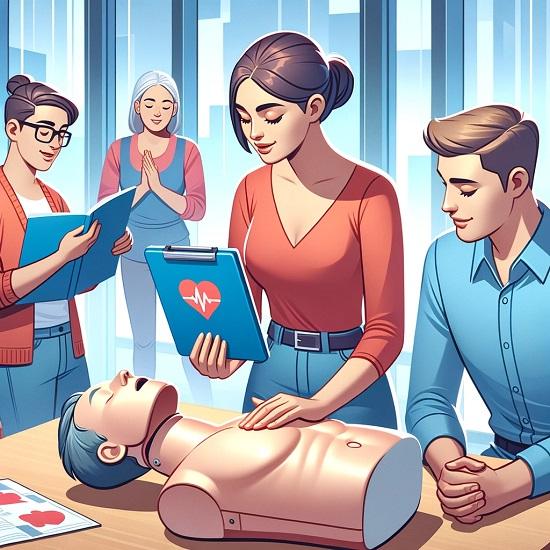Mastering Adult CPR Techniques
Cardiopulmonary resuscitation (CPR) is a critical life-saving skill that can make a significant difference in the outcome of a cardiac arrest. When performed promptly and effectively, CPR can help maintain blood flow and oxygenation to vital organs, especially the brain, until advanced medical help arrives. In this comprehensive guide, we will explore the step-by-step process of mastering adult CPR techniques, including the procedure, steps, and guidelines. We will also discuss the importance of CPR for adults, how to perform CPR on adults, and the key steps involved. By the end of this article, you will have a thorough understanding of adult CPR techniques and be better prepared to respond in emergency situations.
Understanding CPR and Its Importance for Adults
CPR is a combination of chest compressions and rescue breaths designed to maintain blood circulation and oxygenation in the body of a person whose heart has stopped beating or is beating ineffectively. It is crucial to note that CPR should only be performed on individuals who are unresponsive, not breathing normally, and do not have a pulse. The main goal of CPR is to buy time until professional medical help arrives, thereby increasing the chances of survival and reducing the risk of brain damage.
The American Heart Association emphasizes the importance of CPR, stating that it can double or triple the chances of survival for a cardiac arrest victim. The significance of CPR for adults lies in its ability to keep oxygenated blood flowing to the brain and other vital organs, preventing irreversible damage and increasing the likelihood of a positive outcome. With this in mind, let’s delve into the specific steps and techniques involved in performing CPR on adults.
Step-by-Step Guide to Performing CPR on Adults
1. Assess the Scene and the Victim
Before initiating CPR, it is crucial to ensure the safety of the surrounding environment. Check for any potential hazards or dangers that could jeopardize your safety. Once the scene is secure, assess the victim’s responsiveness by tapping their shoulder and asking loudly if they are okay. If there is no response, or if the person is unresponsive and not breathing normally, proceed to the next steps.
2. Call for Help
If you are alone, call 911 or the local emergency number immediately. If there is someone else present, instruct them to call for emergency medical assistance. Time is of the essence in a cardiac arrest situation, and it is vital to activate the emergency response system as soon as possible.
3. Open the Airway and Check for Breathing
Gently tilt the victim’s head back and lift the chin to open the airway. Look, listen, and feel for breathing. If the person is not breathing normally, or if you are unsure, start CPR immediately.
4. Perform Chest Compressions
Position the heel of one hand on the center of the victim’s chest, between the nipples. Place the other hand on top of the first hand, interlocking the fingers. Keep your arms straight and position your shoulders directly above your hands. Begin chest compressions, pressing down fast and hard at a rate of approximately 100-120 compressions per minute. The depth of compressions should be at least 2 inches, allowing the chest to fully recoil between compressions.
5. Deliver Rescue Breaths
After 30 compressions, give two rescue breaths. Ensure the airway remains open by tilting the head back, pinching the nose shut, and making a complete seal over the victim’s mouth with your mouth. Deliver two breaths, watching for chest rise with each breath.
6. Continue CPR Cycles
Continue cycles of 30 chest compressions and two rescue breaths until help arrives, an automated external defibrillator (AED) is available, or until the victim shows signs of responsiveness and normal breathing.
Hands-Only CPR for Adults
In recent years, the American Heart Association has introduced a simplified form of CPR called “Hands-Only CPR” for adults. This approach focuses solely on chest compressions without rescue breaths. Hands-Only CPR is recommended for untrained individuals or those who are hesitant to perform rescue breaths. The key emphasis is on initiating immediate chest compressions, which is critical in maintaining blood circulation.
Conclusion
Mastering adult CPR techniques is a valuable skill that can save lives in critical situations. By understanding the step-by-step process and guidelines for performing CPR on adults, individuals can be better prepared to respond effectively in emergency scenarios. It is essential to stay updated on CPR guidelines and techniques through certified training programs to ensure proficiency and readiness to act when needed. As a responsible member of the community, acquiring and honing CPR skills can make a significant difference in the outcome of cardiac arrest incidents, potentially offering a lifeline to those in need. Therefore, investing time in CPR training and certification is not only beneficial for personal preparedness but also contributes to the overall safety and well-being of the community.










